The First 100 Years 1818-1919






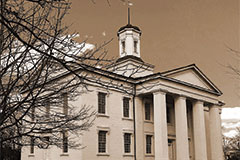

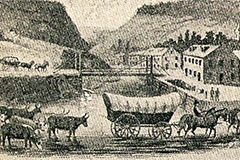

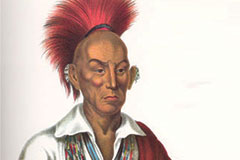

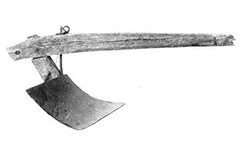

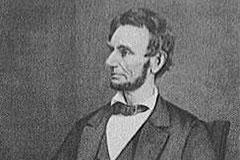

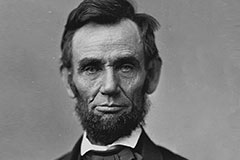

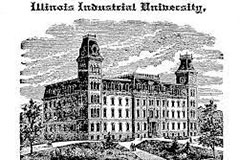









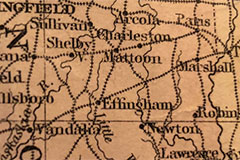

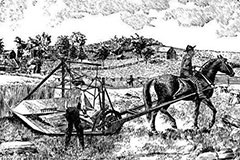

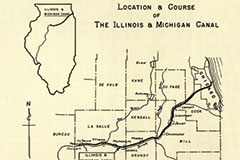

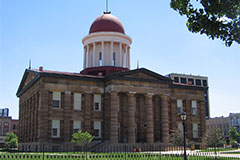

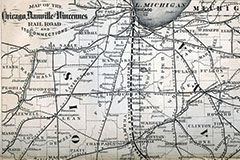





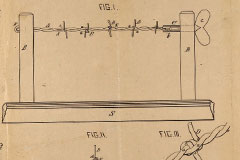

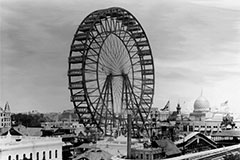


What would you like to find?

Downloadable Media: The First 100 Years
Imagery


Audio























Illinois' leaders and settlers began to push for statehood in 1817. At this time, they did not have enough residents for statehood, but creative census taking made their numbers seem higher. Originally the state would have been only two-thirds of its current size, but Nathaniel Pope, Illinois’ representative in Washington, recognized the benefit of having a port on Lake Michigan. On December 3, 1818 Illinois became a state including some of Lake Michigan’s shoreline and the current site of Chicago. This gave farmers a port for shipping their products. Kaskaskia was the first state capital, though it was soon moved to Vandalia to be more central to the expanding population of Illinois. Illinois’ cheap and productive land attracted immigrants from other part of the U.S., who began to plow the prairies and even drain the swamps, taking advantage of the rich, fertile soil that makes Illinois part of the corn belt. Other immigrants later came from overseas, especially England, Germany and Scandinavia. The hunger for land encouraged many to press into what little Indian land was left in Illinois, resulting in conflicts. In the Black Hawk War of 1832, the U.S. Army drove out the Sauk and Fox Indians, who had displaced the Illiniwek and were some of the last native people in Illinois. Settlers rapidly took over their lands. Oxen, cows, horses, pigs and sheep replaced bison, deer, and bears; and corn and wheat grew instead of tall prairie grasses.
On December 3, 1818 Illnois became the 21st state with Kaskaskia as the state capital.

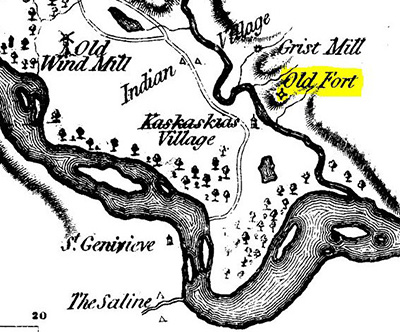
Kaskaskia
The floodplain of the Mississippi River between St. Louis, Missouri, and Cairo, Illinois, can be seen in this southeast-looking photograph. Tree-covered bluffs 100 to 300 feet high line both sides of the river. These bluffs are an extension of the Ozark Plateau to the west (in Missouri), through which the Mississippi has cut a course. In Illinois, east of the Mississippi River, the extension is known as the Shawnee Hills. Kaskaskia Island (the small tree-covered island in the river near the center of the photograph) is the site of one of the oldest settlements west of the Appalachian Mountains. This area has been under the flags of three nations: France, Great Britain, and the United States. Kaskaskia, established by the French in 1703, prospered as an important outpost on the Mississippi and a source of agricultural commodities . During the French and Indian War, the French built a fort on the hill across the Kaskaskia River. Apparently, it was never attacked, and the inhabitants destroyed it themselves after the Treaty of Paris in 1763, when the British assumed control of the Illinois country. During the American War for Independence, George Rogers Clark captured Kaskaskia. From 1809 to 1818, the town served as the first capital of Illinois Territory. When Illinois became a State in 1818, it served as the capital for 2 more years, but after 1820 began to decline. A disastrous Mississippi flood in 1844 destroyed most of the town, and in 1910 another flood completely obliterated the site.
Questions
How has Kaskaskia changed since its early days?
How does this image show one of the disadvantages of being close to the river?
What do you think would have happened if the state capitol had not been moved?
National Park Service, Explorers and Settlers: Fort Kaskaskia State Park; Image Science and Analysis Laboratory, NASA Johnson Space Center. 18 Mar. 2005. " Earth from Space - Image Info rmation
As a result of growing population settling in northern and central Illinois, the state capital moved to Vandalia in 1820.

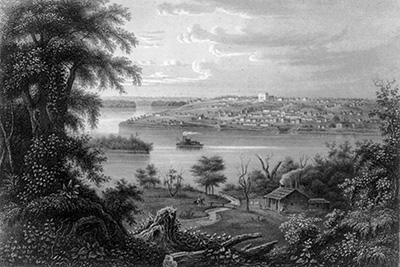
Nauvoo
Immigrants came to Illinois from overseas and from other parts of the U.S. Some of their communities survived, while others failed as immigrants moved on to other locations. American writer Clifton Johnson describes one such town, called Nauvoo, located on the Mississippi River across from Iowa. It was originally settled by a religious group known as Mormons, who later left for the West due to persecutions . They were followed by another religious experiment called the Icarians, who also later left the area. Johnson spoke to the later inhabitants of the town, who were from a variety of backgrounds, and described the city: "Some of the old-time brick buildings are gone altogether, and the only reminders of them are remnants of foundations turned up by the plough and hoe in fields and gardens. Great quantities of fruit are raised, especially strawberries and grapes. The cultivated fields were models of neatness, which may be because the owners are mostly Germans. The Germans are thrifty and are reputed to have plenty of money; but the citizens of a more nervous nationality are wont to affirm that they have no enterprise and do not care whether the town booms or not. "Nauvoo is seriously handicapped by the lack of a railroad. It is true the railroad is within sight on the west bank of the Mississippi, and a steam ferry plies back and forth across the broad stream, making five trips a day; but when the river freezes the only substitute is a rowboat shod with runners. "The placidity of the Germans was an irritation to some of their more strenuous neighbors; yet it was quite delightful in its way. One of them with whom I made friends was a fat elderly man whose pudgy features and blue eyes were always twinkling with a smile. He was a picture of care-free happiness and contentment. When I asked him whether he was going to get a task he had started on that day, he said he did not know. 'I works till I am tired and then I stops,' he explained. He had an osage hedge about his vineyard, and its thorny tangle was something of a trouble to trim and keep in order. 'But dere is a school near,' said he, 'and dot is de best fence dere is for dose poys. Der hedge have so many stickers dey think twice before dey try to get through dot.'". . . Many others of the citizens [are admirers] of the local attractions of the town--its fertile lands and its overlook on the long loop of the river; and they are all quite certain no spot in the whole valley is so beautiful or better suited for the site of a great city. They are sorry the Mormons were driven out; for when they left, the place was larger than Chicago, and there was every prospect of its growing to be one of the biggest and most important towns in the nation."
Questions
What natural advantages does Nauvoo have?
What are its disadvantages?
What stereotypes do you see in this passage?
Clifton Johnson, " Highways and Byways of the Mississippi Valley," New York: The MacMillan Company, 1906.)
National Road is extended to from Marshall to Vandalia.

By the mid-1800s, Illinois was becoming an important agricultural producer, especially of corn, hogs, and cattle. The corn was usually fed to the animals, which were then driven to market. Some grain was also used to feed people and to make alcohol. The Erie Canal, completed in 1825, connected Illinois to New York through the Great Lakes, opening eastern markets to Illinois farmers and bringing more immigrants north. In response to this and pressure from lawmakers such as Abraham Lincoln, the state capital was moved north to Springfield in 1837. The Illinois and Michigan Canal, connecting Lake Michigan to Illinois rivers, was completed in 1848 to help ship Illinois farm products down the Mississippi. That year the state also got a new Constitution. Steam engines powered boats on the lakes and rivers, and railroads were built in Illinois. These allowed customers in Illinois’ cities and other states to buy Illinois agricultural products. Other inventions helped farmers meet the demands for Illinois products. John Deere’s plow and Cyrus McCormick’s reaper improved the efficiency of farming on the prairie, allowing large farms to be planted and harvested. The attention of these inventors was focused on Illinois because they recognized the agricultural importance of the state. Farm implement factories sprang up in Illinois, bringing jobs and further population growth to the cities. Farmers looking for a competitive edge brough better varieties of seeds and animals. These innovations helped the farmer, and allowed consumers to buy affordable, high quality food.
Cyrus McCormick invents the reaper.


Early Farm Machinery
A writer of the early twentieth century said: "Farming was as completely revolutionized during the nineteenth century as every other kind of industry. But the transformation of agriculture began later than that of manufacturing and of transportation. [It] continued with very little change until after 1830. When the first railroads were begun in the United States, plows and harrows were still the only farm implements drawn by oxen or horses. Hay was still mown with a scythe and rakes by hand. Grain was cut with a sickle or a cradle and threshed with a flail. But between 1830 and 1860 farming in our country passed through a period of marvelous changes and expansion. "The invention of farm machinery was by far the most important cause of this wonderful revolution in agriculture. During the generation between 1830 and 1860 many improvements were made in plows and harrows, and a great variety of cultivators, horse-hoes, grain drills, and corn planters were introduced.
The mowing machine and the horse rake began to do much of the heavy manual labor of haying. The first reaper was patented in 1833, and after 1840 reapers rapidly came into use. The invention of the reaper and the threshing machine, which was made about the same time, were two of the most important events in the history of industry. These machines made possible the great crops of grain, which have been grown in our country ever since they were introduced. "While the invention of labor-saving farm implements was the most important cause of the vast expansion of agriculture in our country during the middle of the nineteenth century, several other causes helped to produce the same result. The rapidly growing factory towns were giving the farmers a better home market for their crops. At the same time the peoples of Europe were steadily becoming more dependent upon America for a part of their food supply."
Questions
How did new inventions change American agriculture?
How did these changes benefit America?
What do you think is the most important invention?
Smith Burnham , " The Making of Our Country," Philadelphia: The John C. Winston Company, I 921.)
Black Hawk War between Illinois citizens and remaining Native Americans.


Black Hawk
The arrival of Europeans in North America was catastrophic for native societies. Diseases such as smallpox and measles had destroyed whole communities. Tribes displaced by the new colonists pushed west and came into conflict with people already there. The Illini, a confederation of peoples that had greeted the first French explorers in the late 1600s, had practically ceased to exist by 1800. The Potawatomi, recent arrivals from the eastern shore of Lake Michigan, had occupied the Chicago region by the time the city was founded in the 1830s. Other groups like the Sauk and Fox had also moved into Illinois. Native populations were small. They lived in towns by the rivers where they had reliable water supplies and firewood. Fields near the towns were planted in corn, beans, and squash, and they made maple sugar out of sap. After the harvest, most people moved away from the towns. The prairies were places they used seasonally for hunting and gathering. Yet even though they had little land left, white settlers continued to take it from them.
Visit this site to read a speech from George Corn Tassel. Corn Tassle gave this speech to the US Continental Congress in 1785 . Chief Black Hawk was in Illinois in the 1830s during the period of rapid growth How does Corn Tassle's speech compare to a speech that could have been given by Chief Black Hawk?
Questions
In what ways did Europeans change the lives of Native Americans?
Why did settlers not respect the rights of the native people?
What would your reaction be if you heard this speech?
The Illinois and Michigan Canal is built between 1836-1848.

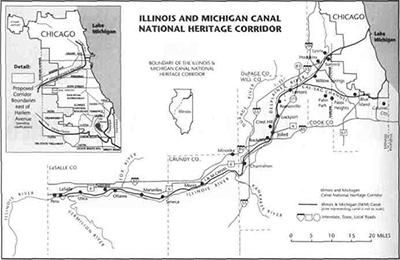
Canals
In the early 1800s, there were few roads, so the shipping of goods over land was expensive. The construction of canals helped solve this problem in some areas. A canal is a man-made waterway through which boats can navigate . The Erie Canal connected Buffalo on the eastern shore of Lake Erie to Albany on the upper Hudson River , which ran south to New York City. When the Erie Canal opened on October 26, 1825, it provided overland water transportation between the East Coast and the Great Lakes region. Under construction for eight years, the project was the vision of New York Governor DeWitt Clinton. He convinced the New York state legislature to commit seven million dollars to the construction of a 363-mile ditch, forty feet wide and four feet deep. A tremendous success, the waterway, linked with the expanding and growing rail system, accelerated settlement of the upper Midwest, including the founding of hundreds of towns such as Clinton, in DeWitt County, Illinois. The canal allowed people and supplies to move between New York City and Buffalo and on to the upper Midwest territories. What used to cost $100 to ship by land now cost only $10 by canal. A journey that used to take a few weeks could now be made in less than seven days. The Erie Canal was an important force in the economic development of the area. The Erie Canal was a marvel of its time and still is today. It offered a new means to transport goods and people, playing an important role in the social and economic history of New York State and the Midwest territories. The Illinois & Michigan Canal, completed in 1848, connected the Great Lakes to the Mississippi River watershed along a longstanding Indian portage route. The 97-mile canal extended from the Chicago River near Lake Michigan to the Illinois River at Peru, Illinois . It rapidly transformed Chicago from a small settlement to a critical transportation hub between the East and the developing Midwest.
Questions
How did the canals, linked with the railroads to form a vibrant transportation network, help Illinois to grow?
How did this change life for farmers? For consumers?
Library of Congress , America's Story from America 's Library: Little Falls Canal Celebration; National Park Service, The Ohio and Erie Canal Towpath Trail; Fish and Wildlife Service , The Erie Canal and Introduced Species; The National Park Service Illin


Steamboats
James Watt's invention of the steam engine in Britain toward the end of the eighteenth century launched the Industrial Revolution. Before the invention of the internal combustion engine, steam was used to power ships. On August 26, 1791, John Fitch was granted a United States patent for the steamboat. He went on to build a steamboat that carried passengers and freight between Philadelphia, Pennsylvania and Burlington, New Jersey. The first steamboats were slow by modern standards, but they opened up a new kind of travel for both cargo and passengers. In 1814, Robert Fulton and Robert Livingston brought commercial success to steam boating. They offered regular steamboat service between New Orleans, Louisiana and Natchez, Mississippi. Before the steam engine , many shippers who used the Mississippi sailed down the river, unloaded their goods, then sold their boats for scrap wood and walked back up river because it was so slow moving upstream. The steamboats traveled at the "breakneck" speed of eight miles per hour downstream and three miles per hour upstream- the average walking speed for a person. In 1816 , it took 25 days for the steamboat Washington to go from New Orleans to Louisville, Kentucky, but improvements were made. By 1853, that same trip took only four and one-half days. Steamboats became very important transportation on the Mississippi. Between 1814 and 1834 , New Orleans steamboat arrivals in creased from 20 to 1,200 a year. Boats carried passengers and all kinds of cargo: cotton, sugar, animals, and later agricultural and industrial supplies. Into the twentieth century, steam pro pulsion became so advanced that you could ride a giant steamer across the ocean. When railroads adopted the technology of steam , they too began to flourish. By the 1870s, they had replaced the steamboats as the major transporter of goods and passengers within the United States. Steam-driven paddleboats still operate on the Mississippi today, mainly as a tourist attraction.
Questions
How did steam power change life for travelers?
For farmers and consumers?
What effect do you think steam power had on the development of America?
: Library of Congress: America 's Story from America's Library. Jump Back in Time , The New Nation (I 790-18 2 8) ; Library of Congress, John Bull and Uncle Sam: Four Centuries of British- American Relations, Invention s and Discoveries.
John Deere invents self scouring plow.
Springfield becomes third state capital of Illinois.

In 1860 Abraham Lincoln, a farmer-turned-lawyer from Illinois was elected President of the United States. Soon after this, the country was torn apart by Civil War. Although Illinois remained loyal to the Union, the southern part of the state contained many ‘Copperheads’, or southern sympathizers. Many Illinois farmers went to fight in the war, which created a shortage of labor, and Southern control over the lowers Mississippi stopped farmers from shipping their products south. Luckily, technological advances allowed Illinois to produce food for Union soldier and civilians. Without the South to provide cotton for clothes, the Illinois wool industry grew. Perhaps the greatest benefit of the Civil War to Illinois, however, was that the national debate over whether the transcontinental railroad should have a northern or southern route was settled in favor of the North. This meant Illinois was on the great railway that would connect the growing country, opening markets across the nation and the world for Illinois agricultural products. Not forgetting his roots, President Lincoln started the first U.S. Department of Agriculture, whose purpose was to serve American farmers, who made up more than half of the U.S. population at the time. The department’s job was to distribute good seeds and information to farmers. Lincoln also signed the Land Grand College Act for loyal states, which allowed the founding of agricultural colleges like the University of Illinois at Urbana-Champaign, helping to spread agricultural knowledge.
Illinois Central Railroad from Galena to Cairo is completed.


Rails
Railways were introduced in England in the seventeenth century as a way to reduce friction in moving heavily loaded wheeled vehicles. The first North American "gravity road," as it was called, was built in 1764 for military purposes in New York. In 1826 a commercial tramroad was constructed at Quincy, Massachusetts. It used horsepower to haul granite needed for building the Bunker Hill Monument from the quarries at Quincy four miles away to the wharf so it could be shipped. These early uses of railways gave little hint that a revolution in methods of transportation was underway. James Watt's improvements in the steam engine were adapted in 1787 to propel ships. Soon the use of steam power for vessels became firmly established. Railroads and steam propulsion developed separately, and it was not until the one system adopted the technology of the other that railroads began to flourish. John Stevens is considered to be the father of American railroads. In 1826, Stevens demonstrated that steam powered locomotives were possible, and railroads began to be constructed. Planning and construction of railroads in the United States progressed rapidly and haphazardly. Before 1840 most surveys were made for short passenger lines, which proved to be financially unprofitable. Because steam-powered railroads had stiff competition from canal companies, many partially completed lines were abandoned. It was not until the Boston and Lowell Railroad diverted traffic from the Middlesex Canal that the success of the new mode of transportation was assured . The industrial and commercial depression and the panic of 1837 slowed railroad construction. Interest was revived, however, with completion of the Western Railroad of Massachusetts in 1843. This line conclusively demonstrated the feasibility of transporting agricultural products and other commodities by rail for long distances at low cost. The possibility of railroads connecting the Atlantic and Pacific coasts was discussed in Congress even before the treaty with England that settled the question of the Oregon boundary in 1846. Chief promoter of a transcontinental railroad was Asa Whitney, a New York merchant active in the China trade who was obsessed with the idea of a railroad to the Pacific. In January 1845, he petitioned Congress for a charter and grant of a sixty-mile strip through the public domain to help finance construction. While sectional issues and disagreements were debated in the late 1850s, no decision was forthcoming from Congress on the Pacific railroad question. During the Civil War, the Railroad Act of 1862 put government support behind the transcontinental railroad and helped create the Union Pacific Railroad, which subsequently joined with the Central Pacific at Promontory, Utah, on May 10, 1869, and signaled the linking of the continent.
Questions
Why were railroads so important for transporting goods?
By looking at the map, what can you tell about how railroads helped Chicago?
How did railroads change America?
What was the importance of the Transcontinental Railroad?
: Library of Congress, American Memory, History of Railroads and Maps
The Election of 1860 has Abraham Lincoln and Stephen Douglas both from Illinois running in a 4 man race for the presidency. Lincoln wins, is inaugurated on March 4, 1861 and the attack on Fort Sumter begins April 12, 1861 which starts American Civil War.


USDA
In 1862, when President Abraham Lincoln founded the U.S. Department of Agriculture, he called it the "people's Department." In Lincoln's day, 58 percent of the people were fanners who needed good seeds and information to grow their crops.
French writer J.J. Jusser and said of Abraham Lincoln 's boyhood on the American frontier:
"No book, school, nor talk with refined men would have taught him what this rough life did. Confronted every day and every hour of the day with problems which had to be solved, problems of food, clothing , shelter, of escaping disease . . . of developing mind and body with scarcely any books but those borrowed from distant neighbors, in doubt most of the time as to what was going on in the wide world, he got in the habit of seeing, deciding, and acting for himself . What the forest, what the swamp, what the river taught Lincoln cannot be overestimated. "
Questions
What lessons do you think Lincoln learned growing up on a frontier farm?
How do you think he was able to educate himself without going to school?
Why did he think it was important to start the USDA?
U.S. Department of Agriculture, About the USDA; J.J. Jusser and, Ambassador of France to the United States , "With Americans of Past and Present Days," London: T. Fisher Unw in, 19 16 .)

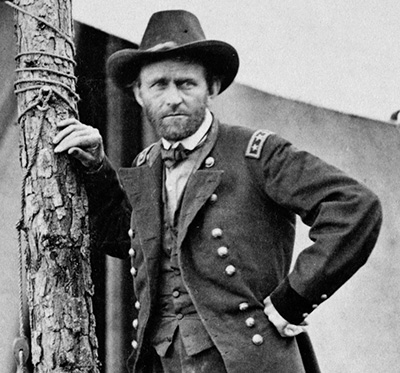
Ulysses S. Grant
In addition to food and fiber for clothes, Illinois contributed many leaders and soldiers to the Civil War, such as President Lincoln and Ulysses S. Grant. At the outbreak of the Civil War, Grant was working in his father's leather store in Galena, Illinois. He was appointed by the Governor to command an unruly volunteer regiment. Grant whipped the regiment into shape and by September 1861 he had risen to the rank of brigadier general of volunteers. His goal was to win control of the Mississippi Valley for the Union. Though Grant was sometimes unpopular, President Lincoln fended off demands for his removal by saying, "I can't spare this man--he fights." For his next major objective, Grant sought to win Vicksburg, an important stronghold on the Mississippi, and thus cut the Confederacy in two. President Lincoln said, "See what a lot of land these fellows hold, of which Vicksburg is the key. The war can never be brought to a close until that key is in our pocket. We can take all the northern ports of the Confederacy, and they can defy us from Vicksburg." Lincoln assured his listeners that "I am acquainted with that region and know what I am talking about, and as valuable as New Orleans will be to us, Vicksburg will be more so." Illinois troops were especially important at Vicksburg, with 36,325 soldiers from Illinois participating in the siege of the city. It ended when Confederate troops surrendered and the Union regained control over the Mississippi River. Illinois had contributed infantry, cavalry, and light artillery, including the Chicago Mercantile Battery, organized by merchants in Chicago, to the struggle. Lincoln appointed Grant General-in-Chief in March, 1864. Grant directed Sherman to drive through the South while he himself, with the Army of the Potomac, pinned down Gen. Robert E. Lee's Army of Northern Virginia. Finally, on April 9, 1865, at Appomattox Court House, Lee surrendered. Grant wrote out magnanimous terms of surrender that would prevent treason trials. He later became the eighteenth President of the United States.
Questions
Why did President Lincoln and General Grant understand the importance of Vicksburg and the Mississippi?
Why would control of the Mississippi be especially important to Illinois leaders, troops, and even merchants?
: White House, Biographies of the Presidents; National Park Service, Vicksburg National Military Park.)
Chicago Union Stockyard opens.
Illinois Industrial University founded. This would become the University of Illinois in 1885.

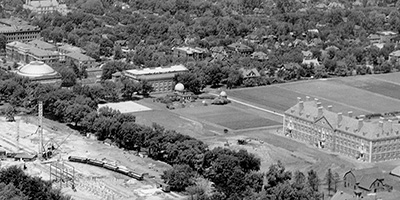
Morrow Plots
Visit this site from the University of Illinois at Urbana-Champaign to learn more about the Morrow Plots, the oldest agricultural experiment in America.
Questions
How do colleges and universities help farmers?
How do they help America?
Why are universities important for everyone?
https://aces.illinois.edu/research/history/morrow-plots

After the Civil War, the technological boom continued for Illinois farmers. McCormick, Deere and other machine manufacturers continued to improve their products. Joseph Glidden of DeKalb County invented the most successful type of barbed wire, which brought a new industry to Illinois, and protected crops from animals better than hedge fences. In 1870 the state got a third constitution in reaction to changes brought by the Civil War. Railroads in Illinois increased, with Chicago as the hub. Food produced in downstate Illinois was brought to Chicago to be processed and shipped by rail or barge to parts of the U.S. and Europe. The course of the Chicago River was even reversed to make it easier for ships to reach the city. Refrigerated rail cars in the late 1800s made it possible to ship meat safely all year long. The cities drew many workers, both from the farms of Illinois and from nations overseas. Because of the improved efficiency of farming, and competition between Illinois farmers and farmers in the West, prices of food dropped. Many farmers struggled to make enough money to survive and joined groups like the Grange to share information and defend their rights. By 1890 successful Illinois farmers knew which foods would best sell and used technologies to run their farms. Dairy farms prospered with the increasing popularity of products like ice cream. Many other farms focused primarily on corn. For farmers, this became a Golden Age of prosperity.
Great Chicago Fire devestates Chicago from October 8-10, 1871.
Joseph Glidden develops and patents his barbed wire.
Jane Addams founded Hull House to provide help to immigrants in Chicago.

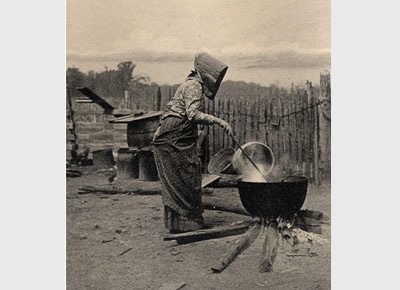
Farming Difficulties
Clifton Johnson, a writer who traveled up the Mississippi, said of southern Illinois, "Where the great river from the east joins the great river from the north stands Cairo, though not exactly in the apex of late years; for the Mississippi has moved away somewhat and left the town a little upstream on the Ohio The railroads monopolized the waterfront, where their engines were constantly hissing and hooting and banging about, filling the air with gas, soot, and cinders day and night. The roads were not passable to a person on foot [because of flooding], and I kept to the embankment and followed its curves and angles for four or five miles The fields were large and smooth, and looked fertile and well-tilled. Here and there were pleasant homes, none of the dwellings fine , but as a rule cozy and clean, with vines and shrubbery and shade trees growing about them.
I stopped at a farmhouse to talk with a sunbonneted white woman who was making soft soap in the yard. She had a fire with a great black kettle over it and said she was, "bilin' the lye . It has to bile slow all the morning," she continued, "till it's very strong. Then I put in the fat I've saved--trimmin's of meat sich as we don't eat, pork rinds, and the cracklin's that we have left when we are trying out lard. After the fat is in I have to stir it every little while with a paddle and be careful not to have too big a fire, or it will bile over. So it simmers along till four or five o'clock and is done; and when it 's stood to cool over night I dip it into a flour barrel. If the soap is all right it's thick like jelly, and I'd much rather have it than the soap you buy. What I make in this kittle will run me a year."
I could see that the recent floods had been up in the yard; but it had not reached the house. "The floods are the worst thing there is about this country," the woman declared. "Now this year the big slues in the fields won't dry out all summer we've had sich an overflow, and we couldn't get our garden broke up till two days ago. I think potatoes had ought to be planted in the dark o' the moon to do real well, and a heap o' people talk thataway; but with the water coming up hyar like it does you have to plant when you can. I was raised in Kentucky, and it always seems to me we got kind of a queer climate hyar. Sometimes it turns in pretty dry, and then ag'in thar's too much rain. I never heared what 'twas like till I come hyar, and I allow I'd 'a'stayed in Kentucky if I'd knowed."
Questions
What difficulties still faced farmers during this time?
Why did they still make soap and other necessities at home?
How does farm life today compare to farm life one hundred years ago?
: Clifton Johnson, " Highway s and Byway s of the Miss is sip pi Valley," New York: The MacMillan Company, 1906
World's Columbian Expostion (also known as the World's Fair) held in Chicago just 22 years after the Great Chicago Fire.


Ice Cream
Though ice cream is very popular, its origins are a mystery. In the 4th century BC the Roman emperor Nero apparently ordered ice to be brought from the mountains and combined with fruit toppings. Legend has it that Marco Polo brought back to Europe a method for creating an ice and milk concoction from his journey to China. Over time, recipes for ices, sherbets, and milk ices evolved and were served in the fashionable Italian and French royal courts. After the dessert made its appearance in the United States, it was served by George Washington, Thomas Jefferson, and Dolley Madison. It also was set out for guests at the inauguration of Andrew Jackson. The use of ice mixed with salt to lower and control the temperature of the mix of ingredients proved a major breakthrough in the creation of ice cream as we know it. The invention of the wooden bucket freezer with rotary paddles facilitated its manufacture. A Baltimore company first produced and marketed wholesale ice cream in 1851. The treat became both easy to distribute and profitable with the introduction of mechanical refrigeration. The ice cream cone first made its appearance at the 1904 Louisiana Purchase Exposition, known as the St. Louis World's Fair and it is from the time of the Fair that ice cream cones became popular. Although paper and metal cones were used by Europeans to hold ice cream and pita bread was used by Middle Easterners to hold sweets, the ice cream cone seems to have come to America by way of "the Pike" (as the entertainment midway of the St.Louis World's Fair was called). The ice cream shop or soda fountain has since become an icon of American culture.
Questions
What helped ice cream become popular?
What other foods can you think of that have become popular?
What affect does it have on farmers and shoppers when a food becomes more popular?
What kinds of ice cream do you like?
Sources: Library of Congress, American Memory, Today in History: July 23.)

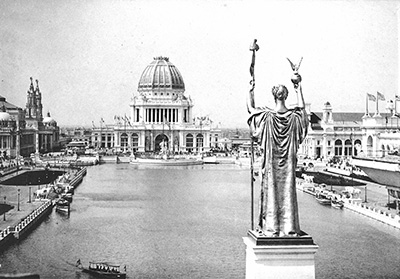
Worlds Fair
Chicago hosted its first World's Fair, the Columbian Exposition, in 1893, just 22 years after the Great Chicago Fire destroyed much of the city. The Fair drew people from across the world, including about one-third of the American population. It celebrated the progress made since Columbus reached the Americas, with speakers and exhibits featuring many new innovations, ranging from Thomas Edison's moving pictures to Cracker Jacks and Juicy Fruit gum. Women had their own building, but some people protested that African Americans were under-represented. One of many inventions displayed at the Fair was the first useful dishwasher, created by Josephine Garis Cochran from Shelbyville, Illinois. Only restaurants and hotels showed interest in the dishwasher during the Fair, but Cochrane founded a company to manufacture her dishwashers, which eventually became KitchenAid®. The Horticulture Building, consisting of eight greenhouses and a huge dome, took up more than four acres of the fairgrounds. Various states and countries sent their best products to represent their agriculture. Illinois' contribution was bay laurels and strawberries, and California built a 35-foot tower out of oranges . Environments were even created to represent a Mexican desert and a Japanese garden.
Questions
How did the inventions shown at the World's Fair change the lives of Americans?
How do you think the horticulture displays at the Fair affected consumers? Farmers?
What kind of inventions do you think you might see if a World's Fair was held today?
National Archives, Teaching With Documents: Petition Signed by Thomas A. Edison for Sunday Openings at the World's Columbian Exposition ; The University of Virginia , World 's Columbian Exposition: The Official Fair--A Virtual Tour; U.S. Patent Office . )

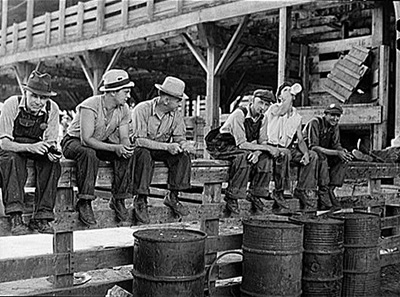
Unions
Many workers joined unions to help protect themselves from unfair company policies. In the 1870s and early 1880s, a group called the Knights of Labor was successful in changing some unfair practices of business, but in 1886, a series of violent strikes waged by railway workers tarnished the union's reputation. In May 1886, police were called in when fighting broke out between striking workers and strike breakers at the McCormick Reaper Works of the McCormick Harvesting Machine Company in the Haymarket area of Chicago, Illinois. Two union men were shot by police and a later explosion killed seven policemen. Although the person who set off the bomb was never identified, four alleged anarchist labor leaders were convicted of conspiracy to commit murder and hanged. Three more remained imprisoned until pardoned by Illinois governor John Peter Altgeld in 1893. The Haymarket Riot diminished popular support for organized labor. Still, unions survived, and continued to help some workers. This story from Chicago factory worker Elmer Thomas gives an example of some of the changes unions were trying to make: "They have a 'credit union' in Armour's, keeps a lot of people out of the CIO [union]. If you want a loan from them you have to have a 'good' record. Well, some fellow, colored fellow, he tried to get a loan. They knew he was a Union man, so they made it hard for him. Told him to get some worker with a bank account in the credit union to vouch for him. Fellow went and got Charlie. Charlie'd been in the yards a long time and he happened to have some money there. He walked into the office and signed them papers, and them in charge of the loans with their eyes popping like a fish' out of water. Manager asked Charlie to step into his private office, he was so upset. He said to him, 'You really mean you want to sign for that man, and he a colored man! I hate to think of a white man would want to take on that responsibility.' Charlie, he's Irish, and he looked at this manager and grinned. He said, 'Well, sure now, I do appreciate that bit of advice, seein' you ain't chargin' nuthin' for it. But that black boy's my friend. He works with me. He's a union brother and I guess maybe you're surprised to hear that I'm with the union, too! So just save that advice of yours for somebody don't know no better.' Walked out of there and slammed the door. You think that colored fellow didn't get his loan? He got it. Manager couldn't do a thing. He really spoke his piece out of turn that time. Got a union man mad, that time, and got himself told."
Questions
Why do you think people joined unions?
What social problems were unions trying to solve?
Why did some people dislike unions?
Do you know anyone today who belongs to a union?
Library of Congress, American Life Histories: Manuscripts from the Federal Writers' Project, 1936-1940; Library of Congress, American Memory, Today in History August 20.)
Elgin Butter debuts as parchment wrapped around 1/4 pound stick of butter.


Golden Age
Writer Clifton Johnson described farm life in the corn belt during the Golden Age of the early 1900s: "Most of the land is cultivated, yet there is much pasturage where numerous cattle, horses, sheep, and hogs graze, and there are frequent streaks and patches of trees. Sheltered homes are scattered broadcast over the face of the earth, and thrift and plenty seem to be universal. Late in the afternoon I called at a farmhouse, and I made arrangements to stay as long as I lingered in the region. My hosts were Americans of the best type--intelligent and prosperous, yet living and working hard. It was a matter of pride to them that they owned a piano. But the thing in the house which gave them the most real satisfaction was a telephone. This connected them with nearly all the farm dwellers in the region and also with the town. . . .At the back of the house were the barns, comcribs, and other buildings. Near the barns were a miry hog enclosure, a cow yard, and a calf pasture. The cattle have a shed closed in on the windward side for their protection and are fed regularly with hay and with com on the cob. A windmill pump keeps the farmyard supplied with water. Every farm has to have its windmill, and you see the slender iron frameworks sticking up all over the country. "The farms vary a good deal in size . Some have only forty acres, others eighty; but one hundred and sixty is the usual size. Many of the farmers have , however, added to their original holdings and own three or four hundred acres, and there are occasional men whose possessions run up above a thousand. In fact, farms are fewer than twenty years ago, and you find frequent deserted houses. . . . Quite a percentage of the farms are rented. . . . I was told 'A feller makin' a fresh start to buy a place has hard pulling. It takes a good deal of money for stock and machinery.' "The farm country is divided with interminable miles of wire fencing into lots mostly of forty-acre size. The people work the land in fields of that extent as a rule, and each field is devoted to one staple. They have no fancy for hand labor, use machinery almost exclusively. Very little hoeing is done; but the com gets considerable cultivating with a two-horse machine, on which a man rides day after day back and forth on the long rows. Most of the corn is husked in the field from the standing stalks into wagons, and the labor continues in the chilly late autumn, for a month or more. Often the last load is not in until about Thanksgiving time. "The farm people get up during the busy season at about five . The field tasks are done by six o'clock, and supper is served; but afterward there are the milking and other odd jobs at the barn and sheds which will keep the workers engaged until about bedtime. In the winter they take life easier, and are not up much before seven. There are seldom any drones in the farm family, and I observed that the housewives by no means confined themselves to indoor duties. . . A good many women in the vicinity milked, and they very often helped in the fields during the busy days of haying and harvesting. Women frequently drive the binders, put the oats into shocks, and some of them do considerable husking."
Questions
What seems familiar to you about this lifestyle?
What seems strange?
What changes has technology made for these farmers?
: Clifton Johnson, " Highways and Byways of the Miss issippi Val ley," New York: The MacMillan Compan y, 1906

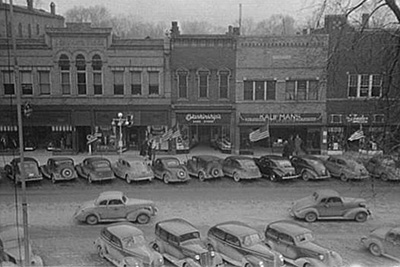
Consumerism
The popularity of the automobile, invented in the 1890s, but made affordable to many with Henry Ford's Model T beginning in 1908, changed the way people lived and shopped. Many no longer had to live close to where they worked, and they could now drive long distances to shop. In fact, if they did not want to drive, they could also have products delivered to them through mail order. Between 1908 and 1940, as many as 100,000 Americans bought their house from a Sears catalog! The houses would be shipped by railroad and would include about 30,000 parts - not counting the nails and screws . All of the major parts were there; the main thing you had to supply was the lot on which to build. In 1908, Model Number 107 sold for between $107 and $650, depending on the options chosen. Many of these mail order houses were built in Downer 's Grove, Illinois. Clothes also changed thanks to mail order and new shopping habits. Before the American Civil War , most clothing was made by tailors or by individuals or their family members at home. During the Civil War, factories began to make men's clothing to meet the demand for uniforms, but women's clothes continued to be custom-made well into the 1920s. Then, changes such as the growth of factories, chain stores, and mail order catalogs led to the growth of the female clothing industry. However, the new ready-made clothing often fit poorly because there was no standard size for the clothes. This led to studies by the USDA and the National Bureau of Standards (or National Institute of Standards and Technology) to set standard sizes to make shopping for clothes in stores and through mail order easier. As the average American became heavier , however, stores began selling bigger clothes labeled with smaller size numbers. The government officially ended the standard for the sizing of women's apparel in 1983, and now, only pattern companies continue to use the traditional sizing standards.
Questions
How do you think these changes affected families living on farms?
What other changes have affected the way people shop?
Is there anything that your family orders through the mail?
Library of Congress, America 's Story from America's Library, Explore the States: Illinois, Sears Catalog Homes: A Local Legacy; National Institute of Standards and Technology, Virtual Museum, Stan dardization of Women's Clothing; Library of Congress, Am

 topics
topics

